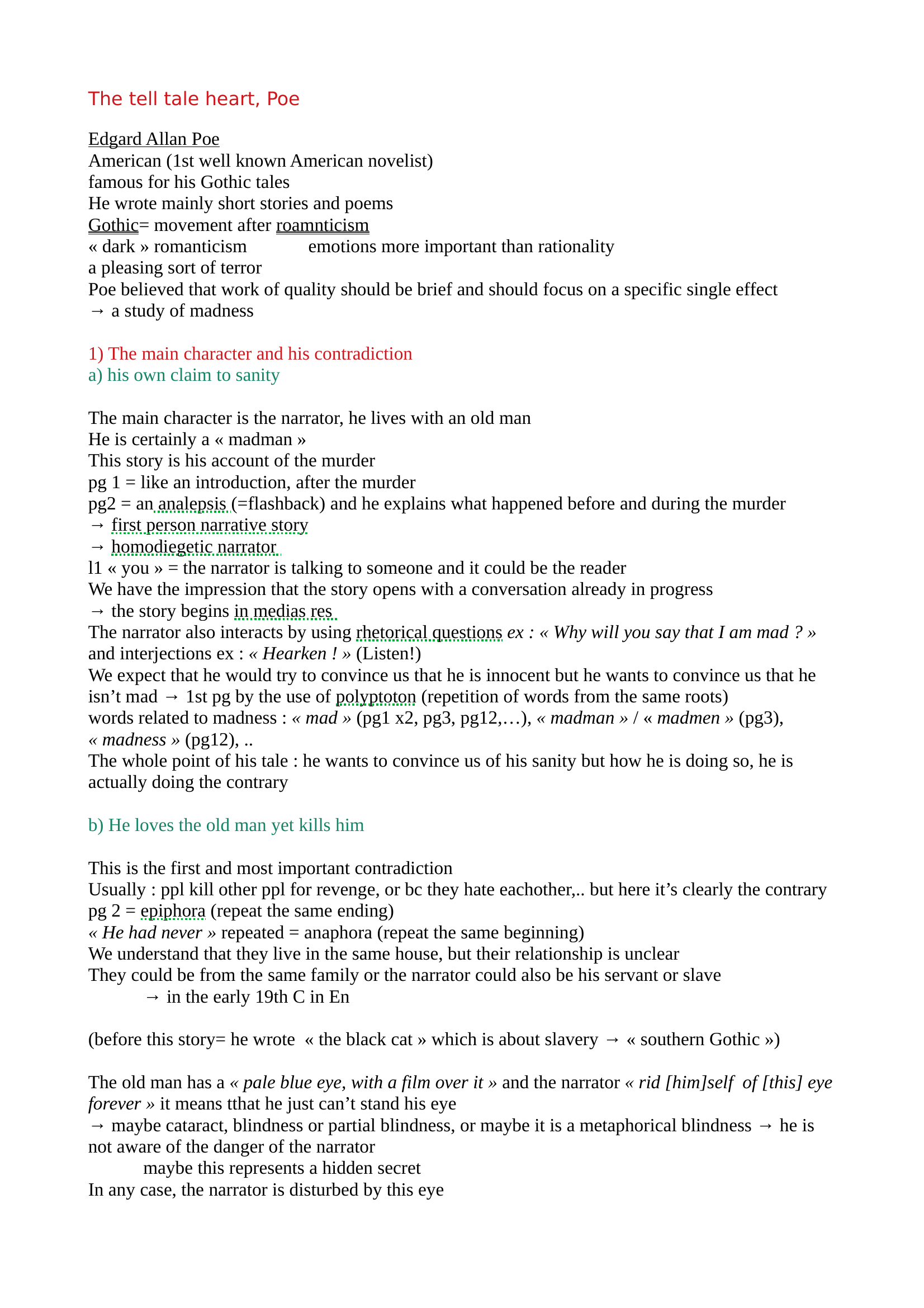The tell tale heart
Publié le 27/04/2021
Extrait du document
The tell tale heart, Edgard Allan Poe Le Cœur révélateur est un récit écrit à la première personne dont le narrateur, s'efforce de convaincre le lecteur de sa lucidité et de sa rationalité, mais qui souffre d'un mal qui \"aiguise ses sens\" . Le vieil homme avec lequel il vit a un « œil bleu pâle, avec une taie dessus », un œil de « vautour », qui cause tant de souffrance au narrateur qu'il décide de l'assassiner. Le narrateur insiste sur la prudence avec laquelle il a commis le meurtre pour montrer qu'il ne peut être fou. Pendant sept nuits, il ouvre la porte de la chambre du vieil homme, action qui lui prend une bonne heure. Toutefois, à chaque fois, l'œil de vautour du vieil homme demeure fermé, ce qui l'empêche « d'accomplir l'œuvre ». La huitième nuit, le vieil homme se réveille et s'assied sur son lit tandis que le narrateur effectue son rituel nocturne. Plutôt que de reculer, celui-ci décide, au bout d'un moment, d'entrouvrir sa lanterne. Un rai de lumière éclaire précisément l'œil du vieil homme, révélant qu'il est grand ouvert. Percevant alors les battements du cœur du vieil homme, animé par la terreur, il décide de frapper: il saute sur le vieil homme en poussant un hurlement, le jette sur le parquet et renverse le lit sur lui. Puis il dépèce sa victime et dissimule les morceaux sous le plancher. Toutefois, un voisin, ayant entendu un cri, a alerté la police. Le narrateur invite les trois officiers qui se présentent à sa porte à fouiller, bien convaincu qu'ils ne trouveront rien. Il leur affirme que le vieil homme est en voyage et montre que ses trésors sont toujours à leur place. Sûr de lui, il leur apporte des chaises, et chacun s'assied dans la chambre du vieil homme, juste au-dessus de l'emplacement où le corps a été enfoui. Alors qu'il se sent de plus en plus à son aise, le narrateur commence à entendre un bruit faible, qui devient de plus en plus fort. Il en arrive à la conclusion que c'est le battement de cœur du vieil homme, sous les planches, plutôt que d'admettre que c'est celui de son propre cœur. Les officiers semblent ne pas avoir remarqué ce bruit. Pourtant, bouleversé par le battement constant du cœur et persuadé que les officiers l'entendent aussi bien que lui, le narrateur finit par avouer le meurtre du vieil homme et leur explique où est dissimulé le cadavre sous le plancher de la chambre où vivait le vieil homme voc :
«
The tell tale heart, Poe
Edgard Allan Poe
American (1st well known American novelist)
famous for his Gothic tales
He wrote mainly short stories and poems
Gothic = movement after roamnticism
« dark » romanticism emotions more important than rationality
a pleasing sort of terror
Poe believed that work of quality should be brief and should focus on a specific single effect
→ a study of madness
1) The main character and his contradiction
a) his own claim to sanity
The main character is the narrator, he lives with an old man
He is certainly a « madman »
This story is his account of the murder
pg 1 = like an introduction, after the murder
pg2 = an analepsis (=flashback) and he explains what happened before and during the murder
→ first person narrative story
→ homodiegetic narrator
l1 « you » = the narrator is talking to someone and it could be the reader
We have the impression that the story opens with a conversation already in progress
→ the story begins in medias res
The narrator also interacts by using rhetorical questions ex : « Why will you say that I am mad ? »
and interjections ex : « Hearken ! » (Listen!)
We expect that he would try to convince us that he is innocent but he wants to convince us that he
isn’t mad → 1st pg by the use of polyptoton (repetition of words from the same roots)
words related to madness : « mad » (pg1 x2, pg3, pg12,…), « madman » / « madmen » (pg3),
« madness » (pg12), ..
The whole point of his tale : he wants to convince us of his sanity but how he is doing so, he is
actually doing the contrary
b) He loves the old man yet kills him
This is the first and most important contradiction
Usually : ppl kill other ppl for revenge, or bc they hate eachother,..
but here it’s clearly the contrary
pg 2 = epiphora (repeat the same ending)
« He had never » repeated = anaphora (repeat the same beginning)
We understand that they live in the same house, but their relationship is unclear
They could be from the same family or the narrator could also be his servant or slave
→ in the early 19th C in En
(before this story= he wrote « the black cat » which is about slavery → « southern Gothic »)
The old man has a « pale blue eye, with a film over it » and the narrator « rid [him]self of [this] eye
forever » it means tthat he just can’t stand his eye
→ maybe cataract, blindness or partial blindness, or maybe it is a metaphorical blindness → he is
not aware of the danger of the narrator
maybe this represents a hidden secret
In any case, the narrator is disturbed by this eye.
»
↓↓↓ APERÇU DU DOCUMENT ↓↓↓
Liens utiles
- The tell-tale heart suite
- Is it always a good thing to tell the truth ?
- Heart of Darkness: symbolism in the book
- Tell us (Terra Mater) Roman A goddess of fecundity, or the ability to produce young.
- Excerpt from The Winter's Tale - anthology.

































